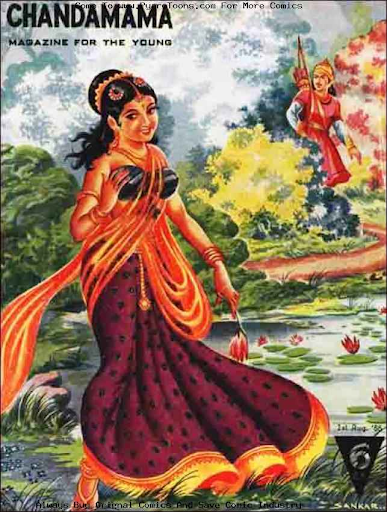For smooth Ad free experience
For smooth Ad free experience
We belong to the land of colourful tales that reflect a legacy steeped in rich imagination and limitless creativity of the mind. Our childhood is stored in comics and cartoons, be it for the sake of entertainment or implicit moral guidance. For years they have defied the general idea of being "unserious" and light-hearted, shaping the moral landscape of several generations.

Story of Chandamama
Before the advent of a century driven by technology, the internet and artificial intelligence, when life did not oscillate between deadlines and computer screens, children were initiated into the world of vivid narratives and stories through numerous children's magazines. Not only were they a steady canvas for artists to consistently display their socio-political sentiments in a moderate tone, but also introduced children to their fantastical and exceptional culture and mythology.
1947 is etched as a landmark for being the year of independence of modern India - formed out of a series of invasions and external domination as a result of colonisation. In a year so politically charged, Chandamama, a children’s magazine began circulating in Telugu and Tamil. Founded by the famous filmmakers Bommireddy Nagi Reddi and Chakrapani or Aluri Subbarao who worked predominantly in the Telugu film industry, Chandamama soon picked up momentum and became widely popular, getting published in more than ten Indian languages.
Storytelling forms a major part of most of our childhoods, doesn’t it?
Imagine an evening swathed in darkness with the candles flickering as you sit huddled beside your grandmother, hearing the sound of crickets. As she narrates stories of a wise tortoise or scheming jackal, a despotic king or an intelligent shoe-maker, you can visualise the world of talking animals and wise shrubbery and a constant tussle between good and evil. Magazines like Chandamama published tales inspired by mythology, fables, parables, hearsay and epics, which almost always possessed a note of the didactic.
Did you know that the artist behind the illustrations of the famous Vikram-Betal series, Karatholuvu Chandrasekaran Sivasankaran, a Padma Shri recipient, passed away in 2020?
The magazine, aimed at providing fantastic renditions of popular legends, shot to prominence with the tale of Vikram-Betal, a reworking of Betaal Pachisi, a Sanskrit literary work. Most of the stories were told in the third-person, building an impersonal world where the impossible becomes possible, but still carried that note of relatability which helps the readers to gain a didactic lesson from the narrative.
The stories in Chandamama were drawn from various historical, literary and mythological texts. However, it was not a “comic book” as it contained several non-fictional contents like national current affairs and “fun facts” or trivia information for their readers' delight. It bridged the gap between the dying fascination for folklore among the new generation by deftly composing captivating stories with equally eye-catching images. One of the main authors of the magazine’s ‘fiction’ segment was Kodavatiganti Kudumba Rao, a big name in the corpus of Telugu Literature. His contributions towards Chandamama’s literary output were manifold. He served as Editor of the magazine for a prolonged duration of 28 years until he died in 1980. Even today, several newspapers publish stories, word games and riddles as a part of their weekly content and Chandamama seems to be the forerunner to this tradition still followed.
Some of the most important artists associated with this magazine were M. T. V. Acharya, T. Veera Raghavan, K. C. Sivasankaran, M. Gokhale and Kesava Rao, among others. They wielded the power to shape an entire generation’s carefree days of childhood. For children, it was their “only access to the world of fantasy and literature”.
However, like how all good things come to an end, a similar fate awaited this magazine too. The improvement in technology led to the popularisation of television, which slowly wiped out the pressing demand for magazines. This led to a fall in circulation, leading to losses. Geodesic Limited, the company that acquired the rights of Chandamama from its original owners in 2007, ultimately witnessed its fall from the zenith. There were talks about The Walt Disney Company acquiring it but eventually, that came to nought. Labour disputes worsened the situation and the final issue of the magazine was in March 2013. With the circulation of the magazine slowly reaching a dead-end, it meant a collective loss of childhood. It was truly the “end of an era”.
0
You might be interested in reading more from
